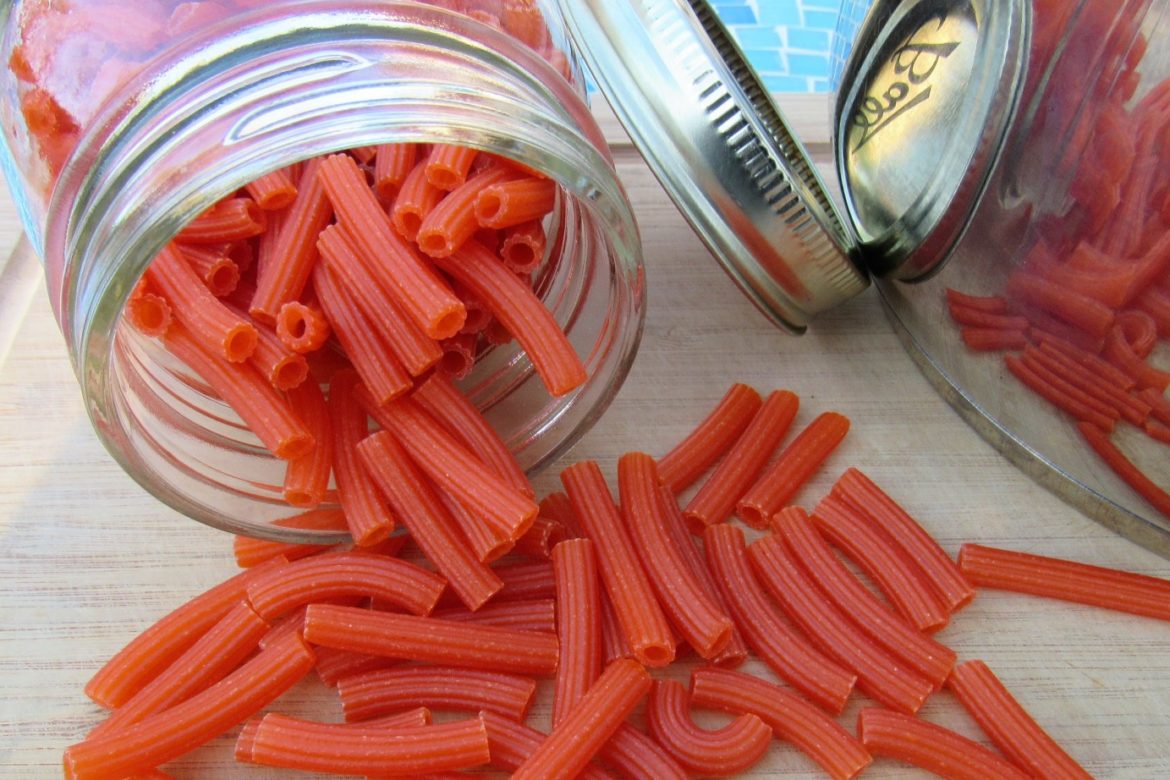
Gluten-free, whole grain, tri-colored, zucchini, whole wheat, quinoa… There are a plethora of noodles out there but which one is the right one for you? What sounds healthy AND what actually is healthy?
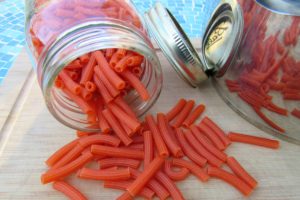
Let’s explore the trendy ones, traditional ones, veggie ones and everything in between so that you can choose the best one for you and your family.
For the purposes of comparison, a 2oz portion of traditional white, dried pasta (spaghetti) will become a reference base:
- Calories: 200
- Carbohydrate: 41g
- Protein: 7g
- Fiber: 2g
- Allergens: wheat/gluten
- Health/nutrient benefits? Fortified with iron and b vitamins
- Pros? Most kids and adults enjoy this type of pasta.
- Cons? Refined grain product- low in fiber and nutrients
One of the reasons traditional pasta is demonized is because it is often served in large portions, contributing to excessive carbohydrate at the meal. Because it is lacking in fiber compared to beans, starchy vegetables and whole grains, it can raise serum glucose (blood sugar) faster. When we think about appropriate portions, the Plate Method is the best visual for anyone to follow, including adults, teens and kids:
- 50% colorful veggies and/or fruit
- 25% high quality protein (animal or plant-based)
- 25% complex carbohydrate
Remember that blood glucose is influenced by everything you eat at the meal, including fiber, protein and fat. That means that if you eat pasta with grilled chicken and vegetables, the protein and fiber slow the rise of blood sugar in comparison to eating a bowl of buttered noodles. Even the order you eat the different foods may affect how your blood glucose reacts (as discussed here).
So, what is the healthiest type of pasta to eat? No pasta fear mongering here! This article will give you the facts and creative ideas you need to make the best decisions for you and your family.
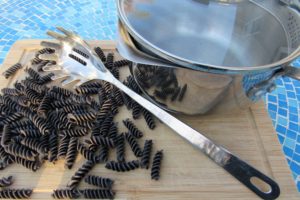
SOME PASTA BASICS…
What does a 2oz portion of pasta look like?
A 2oz portion of spaghetti pasta is about 1 cup cooked. However it differs from ¾ cup to 1 ½ cups (cooked) depending on the shape and size. For example, 2oz of penne pasta is 1 ¼ cup cooked. Because most of us aren’t going to weigh out pasta before cooking, aim to keep cooked portions to about 1 cup. Barilla has a fantastic chart you can use to view portions for your prefered type of pasta. However, brands may differ slightly.
OODLES OF NOODLES
Gluten-Free Pasta
This is pasta that is entirely free of wheat, barley, rye, gluten and traces of gluten. Because GF pasta can be made with a variety of flours and starches, the nutrition value varies significantly among brands. One important point is that the gluten-free stamp does not indicate a superior product. It may or may not be made with whole grains. It may or may not be made with organic products.
For example, the Barilla Gluten Free Spaghetti noodles has the same calories as traditional pasta, less fiber (1 gram) and less protein (4 grams). Made with corn and rice flours, the nutritional value is actually inferior to regular pasta.
One thing that IS common among gluten free pastas is the price tag tends to be higher than for traditional pastas. Some gluten free store brands may offer a better value. If you or a family member requires a gluten free diet, pastas made from beans are an exceptional, nutrient rich option to consider. These are rich in iron and full of protein and fiber (see more about these pastas below).
However, if you have celiac disease, make sure you always look for the certified gluten free stamp on any pasta.
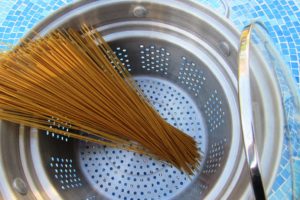
100% Whole Grain & Whole Wheat Pasta
When a pasta is identified as 100% whole grain or whole wheat, it confirms there are no refined grains included in this pasta. Most often these pastas are made with 100% whole grain durum wheat flour. Be careful because whole grain ‘blends’ may include some refined flours- always read the ingredient list. If a package says ‘wheat pasta’ it is traditional white pasta UNLESS the ingredients list only whole durum wheat. Remember white flour is wheat flour so the word ‘whole’ differentiates whole from refined.
Nutritionally, these 100% whole grain pastas have slightly lower calories (180) per 2oz portion. Many have an extra 1-2 grams of protein per serving but what makes these pastas even better is they naturally have more fiber (5-7 grams) and are rich in a variety of minerals (like manganese & zinc) as well as b vitamins. Most brands create a variety of shapes and sizes that are 100% whole grain making it easy to replace everything from spaghetti, mac’n’cheese and pasta-based soups with the whole grain version.
Zoodles Or Spiralized Veggie Noodles
The spiralized noodle craze has taken off! Zucchini, butternut squash, cucumber, carrots- the variations are vast! This is probably the single best way to lighten up a meal without reducing portions. While these vegetables won’t provide the protein boost you can get from some 100% whole grain and bean-based pastas, they are rich in nutrients, flavorful and all provide some fiber.
One medium zucchini provides 33 calories, 2 grams protein, 2 grams fiber and over 50% of your daily needs for vitamin C. About 1 cup of butternut squash will provide 63 calories, 1 gram protein, 3 grams fiber, 300% vitamin A and 50% vitamin C. Considering that many pasta meals don’t include enough veggies to follow the Plate Method, this is one easy and tasty way to do just that!
Most vegetables can be spiralized in less than 1 minute. Then just toss into a non-stick pan with 1 tsp of olive oil for 3-5 minutes to soften on medium-high heat. Learn a few more cooking techniques here. This is my favorite spiralizer to use at home.
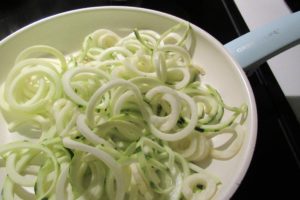
Don’t be deceived, many “veggie pastas” with colorful noodles don’t have the same nutritional value as the actual vegetable itself. AND, most of these pastas are also made with refined wheat flour, keeping the fiber low (2 grams). The calories and protein remain similar to traditional pasta. While these pastas do contain some form of vegetable puree or a dehydrated version of the vegetable, the best way to get the most nutrition is eating the actual vegetable itself.
If you or your family are skeptical about trying spiralized zucchini, carrot, butternut squash (or other veggie) noodles, try a half and half approach. Include some spiralized vegetable noodles with your prefered pasta noodle in your pasta bowl.
Spaghetti Squash
No need to spiralize this vegetable- it grows with ‘spaghetti strands’ already attached!
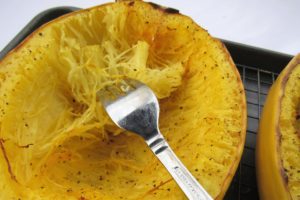
This brightly colored gourd can be found year round in your local produce department. With only 30 calories per cup, spaghetti squash can help fill you up, especially on those hungry days! Learning exactly how to prep and cook it makes this an easy go-to meal topped with some marinara and parmesan. Cooking spaghetti squash is pretty fool-proof and it doesn’t get mushy if you overcook it. Find the best time saving cooking technique here.
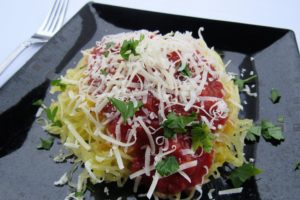
Egg Noodles
Like their name describes, these are noodles made with eggs. While the egg contributes an extra gram of protein (8g), it also contributes 1-2 grams extra fat and 10-20 additional calories. Nutritionally, these are pretty similar to traditional pasta noodles in terms of vitamins, mineral, carbohydrates and fiber. Unless stated otherwise, these noodles are made with refined wheat flour.
One brand, No Yolks, produces noodles made with dried egg whites, keeping the calories and fat similar to traditional pasta. Some lasagna noodles, like these, have eggs in them, but others are egg free. Read ingredient lists, especially for those with an egg allergy.
Shirataki Noodles aka “Miracle Noodles”
Popular in some ‘low carb’ circles, these noodles make quite an impression, but it’s up to you to determine if it’s positive or negative. Made from the native Asian konjac plant, these noodles contain indigestible carbs (fiber) mixed with water and calcium hydroxide (an additive that holds the noodles together). Some brands include tofu (soybeans) as well. Depending on the ingredients, these noodles boast 0-10 calories per serving. That’s right- ZERO.
However, they come in a fishy smelling liquid that turns many off before they even try them. The package instructions usually recommend rinsing them for several minutes in a colander under running water to remove any unappealing flavor or scent and some brands recommend blanching for a few minutes in boiling water. The time to prepare these isn’t any longer than traditional or most any other type of pasta noodles.
One thing to remember is that calories are not bad- they are energy, energy your body needs. If you are not consuming calories through noodles, it’s important to have other nourishing foods at the meal to supply your body with energy. If your body is signaling true hunger, giving it virtually zero calories will fill your stomach for a short time but then you be hungry…again…soon.
Curious about these noodles? You can find them in the refrigerated section of your grocery store where you find the tofu (sometimes in the produce department or ‘natural foods’ area).
Quinoa Pasta
Over the last decade quinoa has made quite an impression, going from a food that no one could pronounce to a staple item in most of our pantries. We know that quinoa is a seed that mimics the texture of a grain, but it contains all the essential amino acids our bodies don’t produce on their own, boosting its overall protein a bit (6 grams protein per ¼ cup dry).
Interestingly, this higher protein seed, when formed into pasta doesn’t boast the same nutritional value you might think. Often, quinoa pasta is blended with either brown rice, amaranth or corn flour. With 4-5 grams protein, 2 grams fiber and about 200 calories, it’s nutrition profile falls short when compared to whole grain or bean pasta.
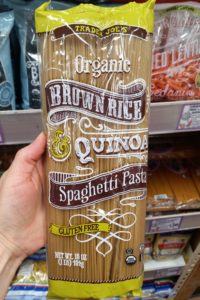
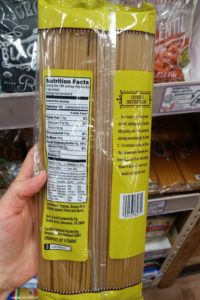
Quinoa is gluten free (it’s a seed, not a grain) so a quinoa pasta blend may be a good option for those needing to avoid gluten or wheat. Don’t forget to look for the certified gluten free stamp if you have Celiac.
Black Bean, Lentil, Chickpea, Mung Bean, Edamame and Adzuki Bean Pasta
Beans have an exceptional nutrition profile boasting protein, fiber, iron, antioxidants, and a variety of minerals. These legumes are often overlooked on the dinner plate, but try out some bean based pasta and they might become a new favorite!
This edamame and mung bean pasta boasts 22 grams protein and 11 grams fiber per 2oz serving… all for about 200 calories! Most of these bean pastas will have 13-20+ grams protein per serving and an average of 10-15 grams of fiber. However, make sure to read the nutrition label. A few, like these Red Lentil Sedanini noodles only have 3 grams of fiber. Even so, they are still a great addition to your meal with 15% iron and 13 grams protein.
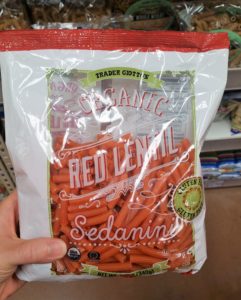
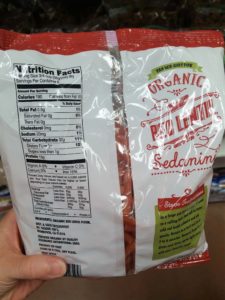
Bean pastas will vary in flavor and texture. Read the cooking instructions carefully and set your timer a few minutes short to test for doneness. Many of these noodles will get gummy if they get too soft so think ‘al dente’ when cooking with them. It was fun to play up “black noodles” (black bean pasta) and “red noodles” (red lentil pasta) with my daughter since we eat with our eyes. Most heavy sauces like marinara or alfredo can cover the bean flavor, but know that it probably won’t taste like traditional pasta.
Soba (Buckwheat) Noodles
Traditionally made from buckwheat flour, these Japanese noodles are often used in hot and cold dishes including soups and stir fries. Buckwheat adds a nutty flavor and grayish brown color but these noodles are otherwise, reminiscent of traditional spaghetti noodles.
Many common soba noodle brands you may find on the grocery store shelves will contain wheat flour (refined) AND buckwheat flour. The combination of these 2 (or more) flours determines the nutrition profile, which means it will vary from brand to brand. However, this brand made of 100% whole buckwheat flour has 6 grams protein and 3 grams fiber per 2oz serving along with a nice boost of the mineral manganese.
Because buckwheat is not wheat at all and does not contain gluten, these noodles may be a good option for those with Celiac or a wheat allergy/intolerance. Make sure to read the ingredients on the nutrition label and never assume gluten free status unless it is stamped with the symbol.
Brown Rice Noodles
Brown rice is a whole grain that is naturally gluten free. Similar to buckwheat, it is rich in manganese. An important part of healthy diet includes variety- this ensures consumption of a wide variety of vitamins, minerals and phytonutrients. Brown rice and brown rice pasta can be included as a part of a balanced meal.
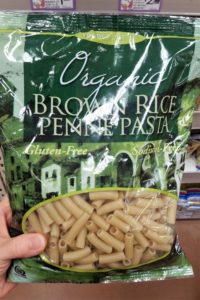
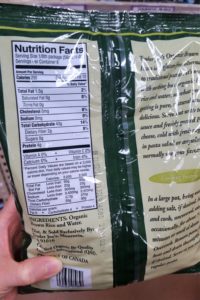
Just because the label claims ‘brown rice’ does not mean it is 100% whole grain. Turn over the package and check out the ingredients. Sometimes white (refined) rice or other refined grains are included as well. Those brands that are 100% whole grain brown rice usually have 4-5 grams protein, 2-4 grams fiber and 200 calories per 2oz serving.
Sprouted Grain Pasta
Whole grains may pack a higher nutrient punch when they have been allowed to sprout (germinate). Research suggests that this process may make certain nutrients like amino acids (protein building blocks), folate and B vitamins as well as vitamin C more bioavailable. Essentially, your body might be able to absorb and use these nutrients better when sprouting has taken place. Therefore, sprouted grain pasta might be worth trying!
This common brand of sprouted grain spaghetti has 9 grams protein and 7 grams of fiber for 210 calories. Sprouted grain pasta may include several different types of whole grains including wheat, barley and millet along with some legumes like lentils and soybeans. Check labels for gluten free, but if it contains wheat, barley or rye, it is not.
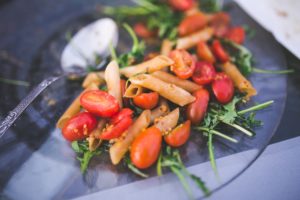
BOTTOM LINE
There are dozens of types of noodle options in a wide variety of shapes and sizes. Remember that ‘gluten free,’ ‘organic’ and other packaging claims does not automatically mean that the product is nutrient dense. The healthiest type of pasta to eat at your dinner table is the one that packs the most nutrients AND your family will actually eat. Packaged whole grain, sprouted grain and bean pastas are usually the highest in protein, fiber, vitamins, minerals and phytonutrients. Always read the ingredient list and glance at the nutrition facts to make sure that you are buying what you think you are buying.
If you have tried a brand before that you or your family didn’t prefer, try another brand as texture and flavor often varies. Mixing pastas containing higher nutritional value with traditional pasta is 1 way to help your family to adapt their taste buds to different products. And if you want a fun way to get more veggies into your noodle bowl or casserole, buy a spiralizer. These low calorie, nutrient dense ‘noodles’ will keep you creating fun, veggie packed meals in a matter of minutes. But regardless of which noodles you choose, keep the Plate Method in mind for balanced, satisfying meals that are yummy too!
DISCLOSURE: This post contains affiliate links. If you purchase a product through this link, your cost will be the same but Healthy Inspiration will receive a small commission to help with the operating costs of this blog. Thank you for your support!

This is the right site for everyone who wants to understand this topic.
You realize a whole lot its almost tough to argue with you (not that I really would want to…HaHa).
You certainly put a brand new spin on a subject that’s been discussed for many years.
Wonderful stuff, just excellent!
Feel free to surf to my website – official statement
Thank you for sharing!